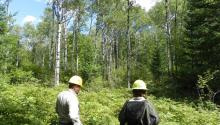

Management Objectives
A suggested outline for climate change adaptation planning on National Forests
Responding to Climate Change on National Forests: A Guidebook for Developing Adaptation Options was developed to summarize current knowledge on climate change adaptation and produce a suggested outline for adaptation planning. The content in the guidebook comes from educational syntheses, tools, facilitated dialogues, workshops, and case studies.
The guidebook is intended to be flexible, giving users the latitude to experiment and meet individual needs. It provides a toolkit to build climate change management strategies, begin science-management dialogue, and presents examples of adaptation options. Four broad steps are recommended as an outline, regardless of the specific processes or tools.
The guidebook suggests these four steps:
- Review - become aware of basic climate change science and integrate that understanding with knowledge of local resource conditions and issues
- Rank - evaluate sensitivity of specific natural resources to climate change
- Resolve - develop and implement strategic and tactical options for adapting resources to climate change
- Observe - monitor the effectiveness of adaptation options
An emphasis is placed on science-management partnerships, where local resource managers and scientists work collaboratively to understand climate change effects, impacts to resources, and management options. These partnerships are critical for successful adaptation efforts.
The guidebook was a product of the WestWide Climate Initiative, a collaboration between the Pacific Northwest, Pacific Southwest, and Rocky Mountain Research Stations. National forests that have followed this guidebook include Olympic, Tahoe, Inyo, Shoshone, Mount Baker-Snoqualmie, and Okanogan-Wenatchee.


